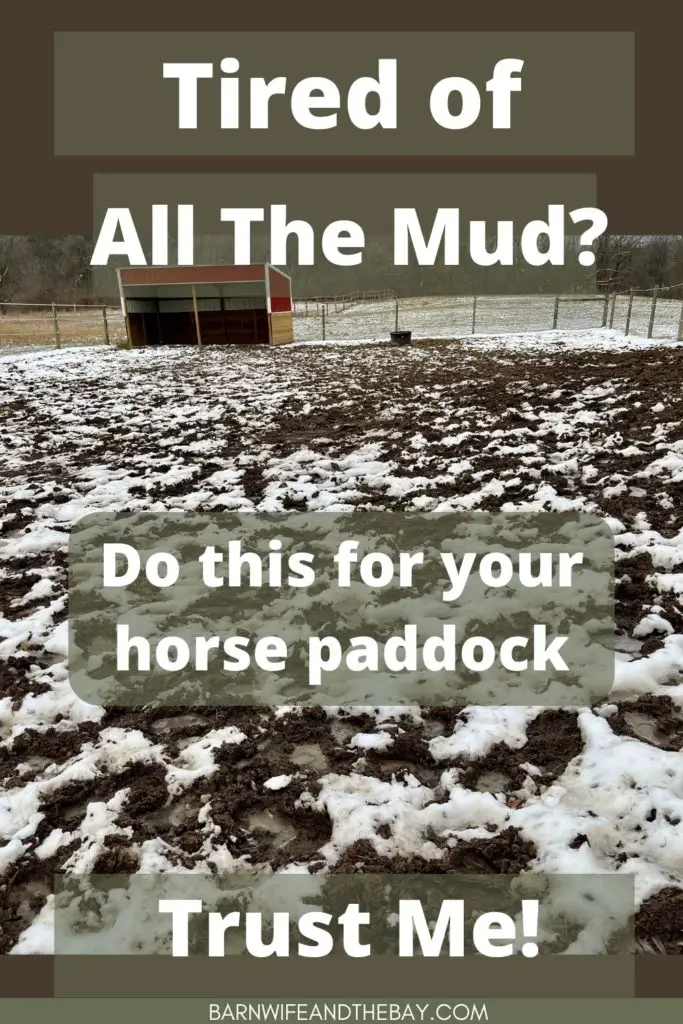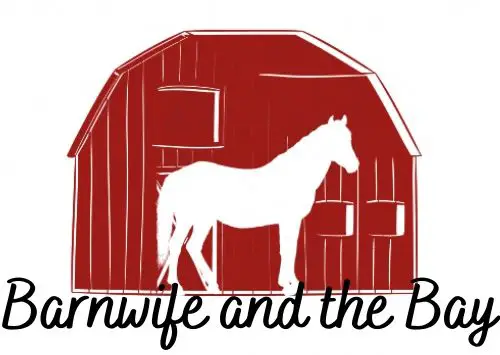At a high level, the two things you need to do to get rid of mud are: 1. Reduce the amount of water introduced to the soil. 2. Improve drainage through the soil.
Almost all of the below solutions address one or the other of these steps. How you will do it depends on your unique situation on your farm.
It’s true that springtime and fall can be absolutely lovely times of year. Until you lose a boot in the mud going to get your horse.
We’ve all been there. Almost all horse owners know the frustration and embarrassment of deep mud claiming a boot or your balance (or even your face!).
Mud issues, and their sisters pasture management and manure management, are some of the most difficult problems a horse farm faces.
Jump to:
Fix your muddy paddocks forever
My farm was very typical, if not worse than average, in the depth and extent of the mud (I do own a young Thoroughbred, after all).
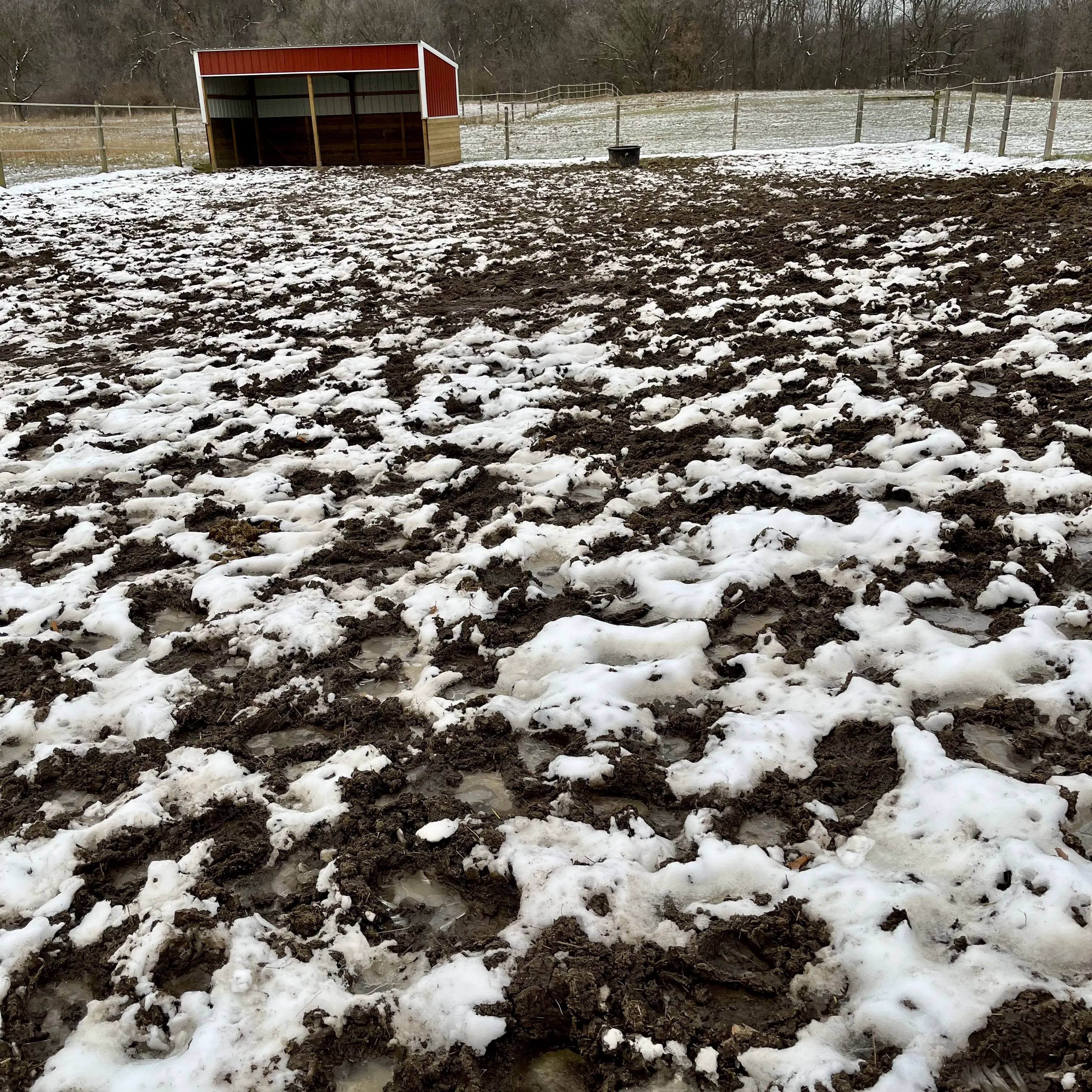
My winter sacrifice area before implementing any mud management strategies.
The mud was bad for months of the year, until we implemented an extensive (and rather expensive) mud management project.
I am here to say it is worth it! There is no more mud anywhere on our farm!
Here is everything we did to banish mud forever, and everything we learned that can help your farm too.
Why you have mud
First of all, where does your mud come from? Obviously, mud comes from dirt that gets wet.
But the underlying reasons for your dirt being wet, and STAYING wet, can be different depending on the situation unique to your farm.
You have horse paddocks that aren’t huge
You’ve made a sacrifice area. Good for you! You’ve done a great thing for your pastures.
Or maybe you’re using all the space you have and the turnout is still just a moderate size.
Horses in one area will lead to a lot of the problems listed below. “Dry lots” are often the exact opposite without a lot of planning and hard work to build them right.
Horses doing all of their moving in one area will lead to soil compaction AND at the same time scoop and churn the top layer into a deep mud smoothie.
I put a lot of planning into the management of my 3 pastures. I planned a sacrifice area almost from the beginning.
The area is generously sized, well over the recommended 1,000 square feet per horse. Even so, it’s not THAT big.
The entire thing got churned up into a deep muddy mess every fall and spring, and often in the midwinter if we got a thaw.
High traffic areas
Even if your pastures are really big, the areas around water troughs, hay feeders, and gates will see a lot of hoof traffic.
Soil compaction
Soil compaction happens when hoof traffic pounds the soil down and living plant matter (which aerates the soil with its root systems) is lost. This makes it harder for water to drain out of the topsoil. When water stands on top of the soil, that’s when mud forms.
Water sources
Rain and snow are obvious culprits. However, nearby streams, low-lying areas, and even a water trough that’s allowed to overflow can be sources of water.
Soil type
Clay soil holds a lot more water, and therefore makes more mud, than sandy soil.
Freeze/thaw cycles
When liquid water from rain or melting snow has nowhere to go because the ground underneath is still frozen, that’s when you’ll get the very worst mud.
This happens throughout the winter and spring in my area, and it’s the hardest problem to alleviate.
The personalities of the horses in your herd
Yes, the individuals who make up your herd will influence how much mud you have. The more they move – romping, running, and turning – the more mud you will have.
At least these movers might suffer less from the health issues mud creates, because of the increased blood flow pumping around their legs all the time? Trying to look for a silver lining here, as I’m the owner of the world’s biggest mud-creator.
Why get better at mud management
There are a few good reasons why mud management is worth all the time, money, and effort.
Your horse’s health
The main reason to think about mud management is your horse’s health. Some health issues that can occasionally happen in cases of unrelieved mud exposure include:
- Mud fever (or pastern dermatitis)
- Hoof abscesses
- Thrush
- White line disease
It’s more likely to be an issue if there is a lot of manure mixed with the mud.
Your own quality of life
Do not underestimate the joy and relief of never having to wade through mud again.
Never having to scrape encrusted mud off of your boots or your horse, and never having to struggle to drag a wheelbarrow or dump cart through the deep mud. Sound good?
Aesthetics
You might enjoy the sight of nice clean sand, gravel or grass more than the sight of a bunch of dirty mud.
How to fix your muddy paddocks forever
Which of these mud solutions you will need to implement will depend on the unique conditions on your farm. Mix and match like I did, using multiple strategies to get rid of your mud.

Number 1 solution: mud grid systems
Mud control grids are the single easiest way I’ve found to handle smaller muddy areas and really high-traffic areas.
The cost is prohibitive to using them to cover a large area, but I love them for run-in sheds, around gates and water troughs.
I have some in my highest-traffic gate area, inside and in front of my run-in shed, and under my water trough.
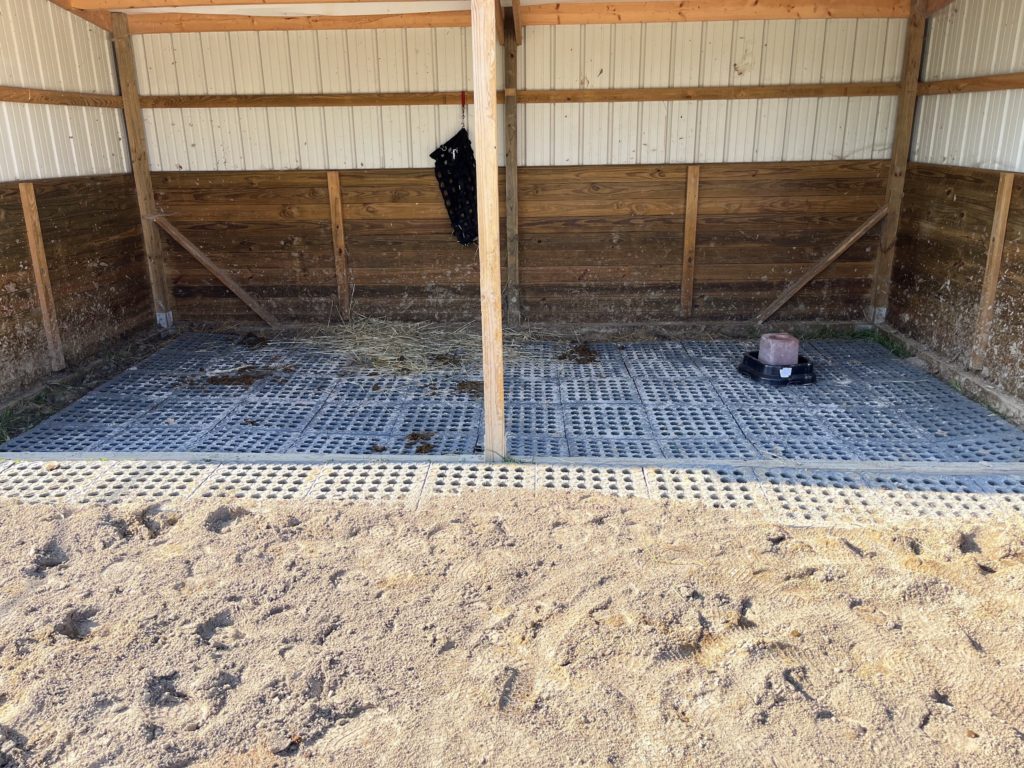
Mud control grids form a dry and stable surface that the horses love inside my paddock shelter.
They are amazing!
Anyone can install them in minutes. You don’t really need to do any prep work on the ground first, although it works a bit better if you do.
The grids sort of float on top of the mud and create a secondary surface which is firm and non-slip.
They even protect the ground under them. So much so that grass can grow through them in my highest-traffic areas. No matter what kind of heavy rainfall we get, the areas with mud grids are solid and firm.
I could go on and on about how awesome these things are, but other mud solutions do exist. Here are some other really good ones:
Keep organic material cleaned up
A big contributor to mud in your horse’s paddock is their manure and dropped hay. Organic matter holds onto water to keep your mud wet and smelly.
Cleaning up manure and dirty hay every day will keep your paddock drier and protect your investment in mud management systems.
French drains
A French drain is a trench in the soil filled with gravel or a drain pipe. This drains water away from paddock areas to another location.
Some farms really benefit from French drains to route water that would otherwise stand in the paddock.
Our situation did not warrant French drains, since our paddock slopes, and creates a natural runoff to the neighbors’ hay field.
Rain gutters
Rain gutters can help keep a lot of water off your paddock in the rainy season if there is a roof where rain runs off into the paddock.
They are unnecessary if the roof, usually of the barn, dumps the runoff onto a grassy or well-drained area.
But our barn roof has a long slope right down into our paddock. The most important thing we did to banish mud was put a rain gutter on that side of the barn.
Rain barrels
Along with gutters, rain barrels can be very helpful to hold excess water and release it slowly, or allow it to be useful to water horses or plants later.
We utilize a rain barrel which collects water from our barn gutters and releases it into a thick stand of grass, which acts as a natural filtration system.
Planting native plants as a natural filtration system
If you have a lot of runoff coming from a specific location, plants can help stop the flow of water. Native plants should grow relatively easily and form a barrier filtration system.
High-traffic pad
A high-traffic pad takes a lot more work to construct than any of the above solutions. But it is one of the most permanent and cost-effective solutions to mud.
It consists of a base layer of filter fabric or geotextile fabric, on top of which is a layer of gravel.
The top layer can be pea gravel, coarse sand, or crushed stone of a fine consistency.
You can also add geocells or Lighthoof grids in the middle layer to add even more stability and longevity. If you choose to buy one of these products, reach out to the company directly to get their guidance on how to install and fill them properly for your situation.
Your local equine extension can be a great resource for specifics on how to build a high traffic pad.
On my farm, the bulk of our work on our dry lot paddock went into constructing a high traffic pad covering the entire thing.
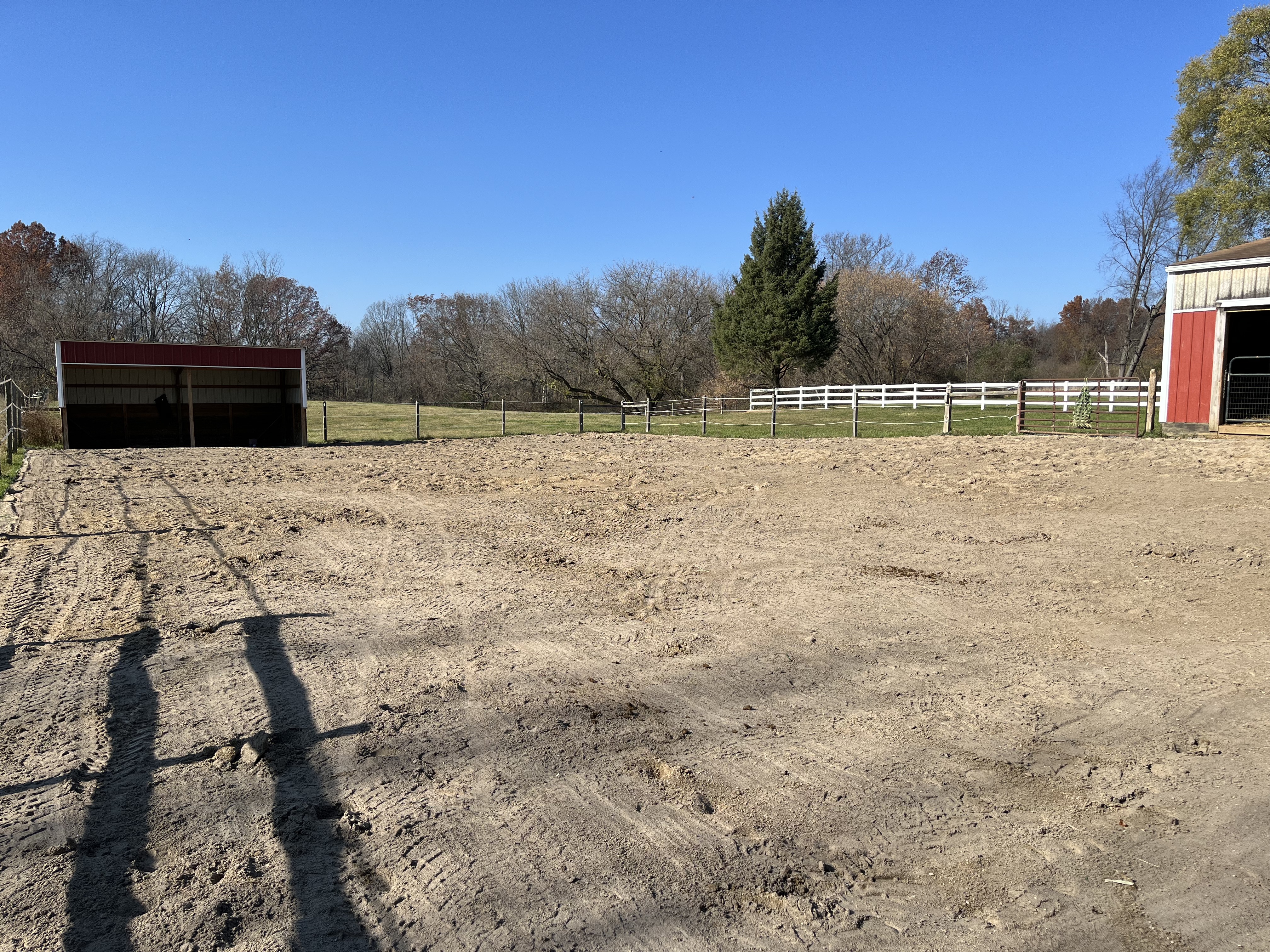
Our dry lot is actually dry now, thanks to a high traffic pad with sand as the top layer.
Sand or gravel alone
Sand or gravel by itself on top of the soil can be a good alternative to constructing a whole high-traffic pad.
In fact, looking back on our dry lot project, we may have been almost as happy with the result if we had only gotten a truckload or two of sand.
Just make sure to choose a type of sand or gravel that will be appropriate for horses to live on. It’s always a good idea to ask your farrier and veterinarian. If possible go to the quarry to look at the different gravel choices.
Sand or gravel alone is not as permanent as the high-traffic pad. You’ll most likely need to add more every year or every few years.
Ideas that sound good but aren’t (trust me)
Here are some ideas that may sound tempting to try, but do not work as well as you might expect:
Rubber mats
Flat rubber mats like stall mats are very tempting to throw down on top of mud.
Take it from my experience, they won’t be on top of the mud long. Flat mats sink right into the mud.
Before they submerge, they will get very slippery. Best save your money and effort.
Wood chips
As mentioned above organic matter holds onto water. Wood products are not as bad as manure and hay, though.
In the short term, wood chips may be a fine solution as long as they are appropriately screened to be safe for hooves.
However there are much better long-term solutions, as wood chips will eventually break down and start to hold a lot more water. Same goes for sawdust.
My top tips for getting rid of mud
Here are my top tips to always, always do when starting to fix your mud situation:
Talk to your local equine extension educator
Equine extension educators are there to help you with your horse farm.
Years ago I contacted mine by email and he came out in person to look at my farm.
He gave me detailed advice about a sacrifice area, runoff, gutters on the barn, and so much more. And it’s a free service!
Work with local pros
When you start your project, whether it’s building a whole new dry lot or getting a load of gravel, work with a local professional who has experience with farms in your area.
Describe your project to them, and listen to what they have to say about similar projects they’ve been involved in.
I worked closely with the gravel provider on our project, and he was so knowledgeable about the needs of different neighboring horse farms even though he wasn’t a horse person himself.
The more real people you talk to about your project, the less likely you are to make a costly mistake. You can always put more sand or gravel down, but it’s extremely hard to take if off!
Now you know about how to manage your mud, it’s time to check in on your manure management plan:
Read everything I learned about how to manage and compost horse manure on our farm!
